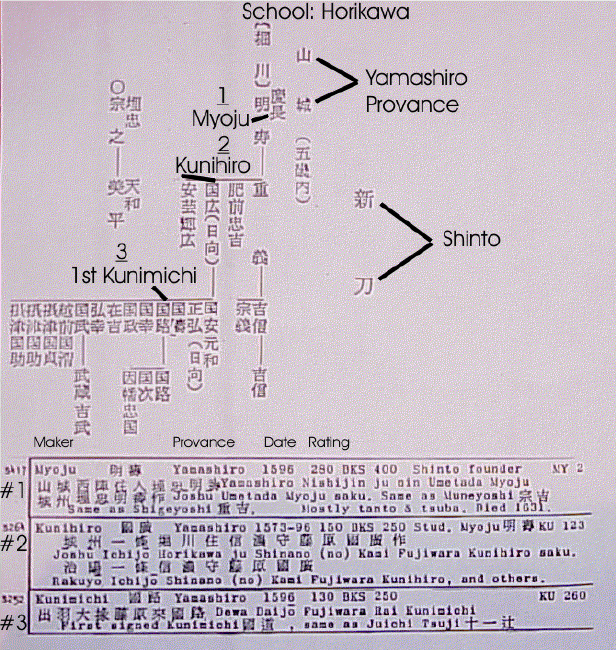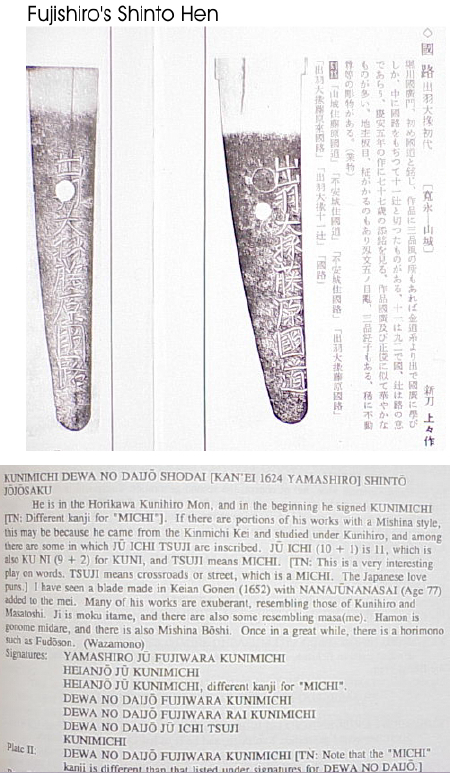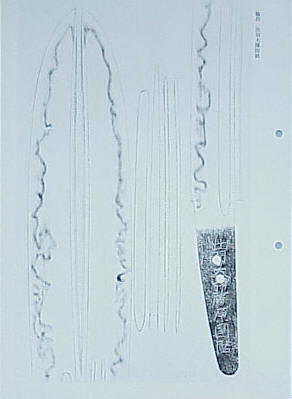KUNIMICHI FIRST GENERATION
Certified Tokubetsu Hozon by the N.B.T.H.K.
© By: David E. J. Pepin
Kunimichi *(#3) descends from the foremost line of master sword smiths of the Shinto period. His teacher (sensei) was the famous Horikawa Kunihiro *(#2) who was the best student of Umetada Myoju *(#1), the founder of the Shinto school.
Kunimichi is considered to have been the best student of Kunihiro. He apparently began his career as a very young man. His first works appeared in Kei-cho 13 (1608). By the time of the passing of Kunihiro in Kei-cho 19 (1614), he had been signing blades “Kunimichi” (at which time he used the same “michi” as Mishina Kinmichi) for six years. At that time, he was given the prestigious title of “Dewa Daijo”. His last works are from Kan-bun 7 (1661). His prolific career spanned 53 years! *Please see the genealogy chart herewith.
Kunimichi *(#3) descends from the foremost line of master sword smiths of the Shinto period. His teacher (sensei) was the famous Horikawa Kunihiro *(#2) who was the best student of Umetada Myoju *(#1), the founder of the Shinto school.
Kunimichi is considered to have been the best student of Kunihiro. He apparently began his career as a very young man. His first works appeared in Kei-cho 13 (1608). By the time of the passing of Kunihiro in Kei-cho 19 (1614), he had been signing blades “Kunimichi” (at which time he used the same “michi” as Mishina Kinmichi) for six years. At that time, he was given the prestigious title of “Dewa Daijo”. His last works are from Kan-bun 7 (1661). His prolific career spanned 53 years! *Please see the genealogy chart herewith.
His works have been awarded Juyo Token on numerous occasions; many of them are his Shoshu-style masterpieces. The N.B.T.H.K. has revealed some very interesting facts, regarding Kunimichi. Amongst them is that he was related to the Mishina Kinmichi kei. This is due to his frequent use of the Mishina-style boshi, the early use of the same “michi” as Kinmichi, and later in his life the use of “rai” as with Rai Kinmichi. Kunimichi’s works also emulate those of the “Shizu” school. Kaneuji, the founder of the Mishina School, is directly descended from Shizu Saburo, a student of Masamune (see “The Mishina School” by David E. J. Pepin). He also occasionally worked in the style of the Sa, Monji, and Bizen schools. The style he most preferred was that of the Shoshu school, at which he excelled.
Frequently displayed characteristics of a Kunimichi blade are: deep nei, noi, utsuri, ji nei, chikei, kinsuji, inazuma, sunagashi, ashi, and tobiyaki. The most often seen hamon is gonome midare. Horimono are rare. His normal yasurime is sujichigai style. His superb hada, that is most frequently itame/mokume with thick ji nei and jikei, it has the appearance of being moist. Some of his blades have a bluish color. This is seldom seen in Shinto blades, and is reminiscent of the blades of the Kamakura and Nambokucho periods.
Dewa Daijo Kunimichi is considered to be among the “best of the best” (jo-jo saku) of the Shinto period. The N.B.T.H.K. Juyo award books refer to him as possessing “superb techniques.” His blades are graceful and strong, and are highly sought after.
Below is a very similar Juyo Kunimichi example from a Juyo ZUFU book
Images of our “KUNIMICHI”
MEI- (SIGNATURE): “DEWA DAIJO FUJIWARA KUNIMICHI”
MAKERS DATA:
PROVINCE: YAMASHIRO
GRANTED TITLE; DEWA DAIJO (IMPORTANCE LEVEL, HIGH)
CLAN: FUJIWARA. HE EXHIBITS STRONG SHOSHU, AND MISHINA / SHIZU INFLUENCE
IN HIS BEST WORKS.
SENSEI- (TEACHER): “HORIKAWA KUNIHIRO”, BEST STUDENT OF “UMETADA MYOJU”.
IMPORTANCE LEVEL; VERY HIGH +
“KUNIMICHI IS CONSIDERED TO BE HIS FINEST STUDENT”!
NENGO- (DATE): APPROXIMATELY 1625 AD
KANTEI- (CERTIFICATION); TOKUBETSU HOZON TOKEN
CERTIFICATE # 148657BY: N.B.T.H.K. (Nihon Bijutsu Token Hozon Kyokai), OFFICIAL JAPANESE
GOVERNMENT SWORD FOUNDATION, TOKYO JAPAN.
SIGNIFICANCE: PUBLISHED (AVERAGE FROM SEVERAL REFERENCES) VALUE INDEXRATING’S: “VERY HIGH”
BLADE TYPE: WAKIZASHI / *O-TANTO*THIS STYLE OF BLADE IS CONSIDERED TO BE AN O-TANTO BY MANY.
DIMENSION’S:
NAGASA- (BLADE LENGTH); 15 1/2″ – 39.7 cmSORI- (BLADE CURVATURE); 3/8″ – 9 mm
MIHABA- (WIDTH); 1 1/8″ – 2.7 cm
BLADE STYLE: KEIJO NIKEI
OMOTE; (SIDE WORN AWAY FROM BODY) *SHOBUZUKURI (SHINOGI LINE, WITH NO
YOKOTE, LIKE AN IRIS LEAF).
URA; (SIDE WORN NEXT TO BODY) *HIRAZUKURI (FLAT SIDED). *BOTH STYLE’S
THAT ARE NORMALLY SEEN IN TANTO’S.
MUNE- (BACK RIDGE): “MITSU MUNE” (3 SIDED SHOSHU STYLE).
HADA- (BLADE STRUCTURE): ITAME / MOKUME MIXED, HAVING DEEP JI-NIE
(CRYSTALLINE DOTS, AS IN THE HAMON), AND CHIKEI (THIN LINE’S OF
MARTENSITE JUST BELOW THE SURFACE) EXTREMELY DIFFICULT TO ACCOMPLISH,
AND GIVING THE HADA A “WET” APPEARANCE VERY DESIRABLE! ALSO
THOUGHT TO BE A FACTOR IN GIVING A BLADE ITS RARE BLUISH COLOR [IMAGE #5].
HAMON- (TEMPERING PATTERN): NOTARE MIDARE
DETAIL’S; “UTSURI”, SHADOW LIKE PATTERN ABOVE THE HAMON, FOUND ONLY ON
THE HIGHEST QUALITY BLADE’S. IT IS SAID THAT UTSURI IS LIKE THE
REFLECTION OF THE HAMON IN A POOL OF WATER THICK
NIE, NIOI, SUNAGASHI (CRYSTALLINE LINE’S, LIKE THE VEINS IN A LEAF),
KINSUJI (GOLDEN LINES).
BOSHI- (TEMPERING AROUND POINT): SAKI TOGARI, JIZO (LIKE A MONKS HAIRSTYLE)
HORIMONO- (BLADE ENGRAVING): BO-HI NI TSURE-HI (TWO LONG NARROW GROVE’SCOMING TOGETHER AT END)
NAKAGO- (TANG): UBU, TWO MEKUGI ANA (HOLES), FUTSU (NORMAL) SHAPE,KURIJIRI (CHESTNUT SHAPE END).
YASURIME- SUJICHIGAI
KOSHIRAE- (FITTINGS): SHIRA-SAYA (STORAGE HILT & SCABBARD), MADE FROM WOODAGED FOR DECADES.
HABAKI- (COLLAR): TWO PIECE, SOLID GOLD WRAPPED, FINEST QUALITY.
POLISH: SASHIKOMI (SHOWING DETAIL). RECEIVED A JUYO CLASS OF POLISH,HIGHEST QUALITY.
CONDITION: EXCELLENT + (SEE ALL PHOTO’S)
KIZU- (DEFECTS): NONE
RARITY LEVEL: VERY HIGH, THIS IS THE ONLY BLADE OF THIS STYLE, I HAVEEVER SEEN BY KUNIMICHI, THE QUALITY IS FANTASTIC!
NOTATIONS: KUNIMICHI 1st, IS THE 2nd DECEDENT FROM THE FOUNDER (UMETADA
MYOJU) OF THE SHINTO SCHOOL OF SWORD MAKING. HIS WORK IS RARE AND HAS
RECEIVED THE HIGHEST HONOR’S.
HIS BLADE DISPLAYS ALMOST EVERY DESIRABLE CHARACTERISTIC THAT IS
ENCOUNTERED. THIS IS ONE OF HIS “SOSHU STYLE” MASTERPIECES, OF WHICH
THERE ARE FEW SURVIVING. THIS BLADE ALSO POSSESSES THE “BLUE HUE”. THIS IS NORMALLY FOUND IN
KAMAKURA (1186-1332 AD) & NABOKUCHO (1333-1392 AD) BLADE’S. IT IS SELDOM
SEEN, AND EXTREMELY DESIRABLE.
This Sword is not available for purchase.
If you wish to purchase a Japanese Sword, please view our Nihonto for sale page or contact us directly via email or by telephone at 1(608) 315-0083 any time. Please include specifics of what you seek, i.e.: Katana, maker, era, price range, etc.
Pictures and content may not be copied without the express permission of samuraisword.com ©
















